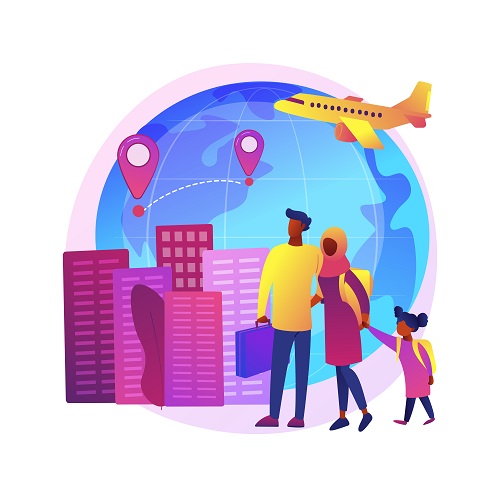Asylum, Refugee & Humanitarian Immigration



Whether you’ve fled your home seeking safety or are considering starting fresh in a new country for humanitarian reasons, navigating asylum, refugee, and humanitarian immigration services can feel overwhelming. This guide aims to break it all down for you—what these services encompass, why they’re so essential, what challenges they present, and how you can go about obtaining them.
What Are Asylum, Refugee, and Humanitarian Immigration Services?
At their core, these services are programs and legal pathways designed to provide protection, support, and a chance at a new life for individuals who cannot safely return home. While these terms are often used interchangeably, they differ in scope and context.
Asylum
Seeking asylum involves requesting protection from a country when someone has already entered or crossed into its borders. It applies to individuals who have fled persecution based on race, religion, nationality, political opinion, or membership in a particular social group.
Refugee Services
Refugees are individuals who are recognized as having fled their home country due to a well-founded fear of persecution. Determined through international or national systems, refugees often wait in camps or third-party countries before being resettled elsewhere.
Humanitarian Immigration Services
This category includes broader protections for individuals facing urgent dangers, such as natural disasters, armed conflicts, or dire human rights violations that make returning to their home country impossible.
Each of these pathways plays a critical role in safeguarding at-risk individuals, demonstrating global compassion, and adhering to international agreements like the 1951 Refugee Convention.
Why Are These Services Important?
Access to asylum, refugee, and humanitarian immigration services is crucial for several reasons:
- • Protection from Harm: These services provide life-saving refuge to individuals who would otherwise face persecution or violence.
- • Restoring Dignity and Stability: They offer displaced individuals a foundation for rebuilding their lives, including access to education, healthcare, and employment.
- • Human Rights Advocacy: By supporting refugees and asylum seekers, countries affirm their commitment to human rights and uphold international obligations.
Beyond individual protection, these services promote cultural exchange and diversity and highlight the humanitarian values that define us as global citizens.
Challenges in the System
While these services are essential, they’re not without challenges.
Bureaucratic Complexity
The application processes for asylum, refuge, or humanitarian visas are often lengthy and involve complicated legal procedures. Many applicants lack the resources or understanding to navigate these systems alone.
Overburdened Systems
Due to global conflicts, economic instability, and climate crises, more individuals than ever are seeking refuge. This demand can overwhelm immigration systems, leading to delays and resource shortages.
Political and Social Barriers
Immigration policies can vary significantly depending on the country. Negative public sentiment toward immigrants may also influence regulations, making it harder for applicants to receive fair treatment.
Mental and Physical Strain
For asylum seekers and refugees, these processes often accompany profound emotional and physical challenges, including trauma from persecution, separation from their families, and living in uncertain conditions. Understanding these challenges underscores the need for streamlined processes and services dedicated to vulnerable migrants.
Types of Humanitarian Immigration Pathways
Several specific humanitarian and protection pathways are available, depending on individual circumstances and the country’s immigration policies.
While Study & Exchange Visitor Visas unlock tremendous opportunities, the process can be challenging. Here are some common hurdles and how to overcome them:
Political or Religious Asylum
This applies to individuals persecuted due to their beliefs or affiliations. Applicants must provide evidence of credible fear and show how returning to their home country endangers them.
Refugee Resettlement Programs
Managed by organizations like the United Nations High Commissioner for Refugees (UNHCR), these programs identify and relocate refugees to countries that can offer permanent safety.
Temporary Protected Status (TPS)
Countries offering TPS provide temporary relief for migrants fleeing extreme conditions, such as natural disasters or armed conflict. While it’s not a pathway to permanent residence, it ensures safety for a limited time.
Humanitarian Parole
This allows individuals with urgent humanitarian needs to enter a country temporarily. It's typically approved for specific situations, like accessing medical treatment.
Family Reunification Programs
Certain programs allow refugees and asylees to petition for close family members to join them in their new country, promoting familial bonds and support systems.
Steps to Obtain Asylum, Refugee, or Humanitarian Protection
The exact steps vary by country, but here’s a general guide to navigating the process.
Research Your Options
Understand the pathways available in your chosen destination. Each country has its own application procedures, eligibility criteria, and timelines. Seek credible resources, such as the country’s immigration website or humanitarian NGOs.
Gather Documentation
Gather evidence to support your application, such as identity documents, proof of persecution, and statements from witnesses. Organize these documents clearly and ensure their authenticity.
File an Application
Whether applying for asylum, refugee status, or humanitarian visas, ensure you meet all submission deadlines and provide detailed, accurate information. Missing paperwork or errors can delay or jeopardize your case.
Attend Interviews or Hearings
Applicants are often required to participate in interviews or court hearings to present their case. Be prepared to explain your situation clearly and answer questions from authorities.
Seek Legal Assistance
Navigating these processes alone can be challenging. Many NGOs, legal clinics, and lawyers specialize in immigration and asylum law, offering pro bono or low-cost services.
Be Patient but Proactive
Processing these cases can take months or even years. During this time, stay informed about updates to your case and comply with any requests from authorities.
Building a Support Network
The emotional toll of seeking protection can’t be overstated. Building a strong support network is essential for your well-being. Connect with Community Organizations: Many nonprofits assist asylum seekers and refugees by providing housing, legal aid, and other essential services. Seek Mental Health Support: Experiencing displacement and persecution can cause trauma. Look for organizations offering counseling or peer support groups. Engage with Local Communities: Integrating into social and cultural activities can foster a sense of belonging in your new home.
A Better Future Begins Here
The asylum, refugee, and humanitarian immigration process can be daunting, but it’s also a pathway to safety, stability, and new opportunities. Understanding your options and the steps involved will empower you to take control of your future. If you’re unsure where to start or need guidance, reach out to trusted legal services or community organizations. Support and resources are available every step of the way.

World Connect Immigration
WCI provides a very fast and responsible advice legal service.
Copyright 2025 World Connect Immigration, All Right Reserved








